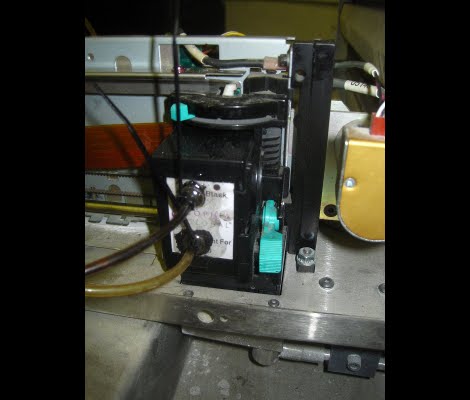
[Nullset] uses inkjet printer technology for his 3D printing needs. We usually think of hot-plastic printing like the RepRap or Makerbot when we hear about rapid prototyping, but this setup uses a liquid bonding agent to turn powder into a solid structure. Standard inkjet cartridges can be used to precisely place the bonding agent, but it’s hard on the heads and you have to replace them often. [Nullset] is getting pretty good at it, and decided to write a tutorial on the modifications necessary to print with bonding liquid.
At its core, the method injects binder into the cartridge through one port while using a second for drainage. [Nullset] found that the needle fittings used to inflate a basketball work great for this. He drills a couple of holes that the threaded end of the needles fit into. That connection is sealed with some epoxy, and the tubing that delivers the binder is zip-tied to the needles. A bit of purging is necessary to get rid of any old ink, but after the initial flush you’ll be up and running pretty quickly. He figures the whole process can be one in around 10 minutes once you get the hang of it.
















Good tutorial, but nothing extraordinary about it. It’s just what i (and maybe many others) would have thought of given the task.
I’m still waiting for some sort of ink that hardens and turns into the printed part itself..albeit the possible very long printing time the resolution should be great.
I have seen the Objet printers use this method. they seem to use various UV curable compounds, which are built with an inkjet system in 16 micron layers. can even do multimaterial. I think it would be a valid experiment to see if one can use compounds purchased from them with a hacked printer printhead and gantry system. I just cant seem to find any resources that describe how to interface to typical off-the-shelf printheads…
Of course it’s nothing extraordinary. It does, however, save around $160+/print cartridge. These cartridges cost $175 each from Z Corp. That makes 3D printing unfeasibly expensive. $10 each is much more reasonable, and enables us to experiment with the technology.
Oh, and the warranty is probably void :)
hi !!! great tut !! thank you !
i’ve my own ideas . i like to use old copiers to print 3d parts.
do i have to fill all the color cartridges. can i use laser from dvd players
to harden uv resins [will dirty resins[ colored]] work or dose it have to be
in the uv to hearden . can an additive filler [powder binders] like hydrocal or hydroperm be added into resin [in the cartridges] to print? or is there a chemical way to harden the printed layers?
looking forward to your ideas’
thank you!
michael g mesa az.
Hi,
i’ve heard of a novel faster way to 3D print with plastic that could take advantage of inkjet printing heads.
The 3D printer moving head prints a dark ink mask on a white platic powder layer and carries a large Infrared lamp.
The dark ink absorbs more heat from the lamp that the surrounding white powder, until it brings the powder to melting point where it’s colored dark, thus binding the powder grains.
Hi I wonder if an inkjet head could deliver enough water droplets to efficiently bind a plaster or cement powder layer.
The water volume magnitude should be around: printing surface * half of layer thickness.
For a 4×6 inches size printing surface, and 50µm thick, layers,thiis means the head should be capable to deliver a water volume about: 0.25 cm3/s.
Is that realistic?